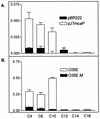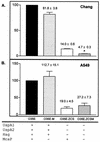Identification of a Moraxella catarrhalis outer membrane protein exhibiting both adhesin and lipolytic activities
- PMID: 12874311
- PMCID: PMC166007
- DOI: 10.1128/IAI.71.8.4341-4350.2003
Identification of a Moraxella catarrhalis outer membrane protein exhibiting both adhesin and lipolytic activities
Abstract
The UspA1 and Hag proteins have previously been shown to be involved in the ability of the Moraxella catarrhalis wild-type strain O35E to bind to human Chang and A549 cells, respectively. In an effort to identify novel adhesins, we generated a plasmid library of M. catarrhalis DNA fragments, which was introduced into a nonadherent Escherichia coli strain. Recombinant E. coli bacteria were subsequently enriched for clones that gained the ability to bind to Chang and A549 cells, yielding the plasmid pELFOS190. Transposon mutagenesis of this plasmid identified the potential adhesin gene mcaP (M. catarrhalis adherence protein). Sequence analysis revealed that McaP is related to autotransporter proteins and has substantial similarity with the GDSL family of lipolytic enzymes, particularly the Moraxella bovis phospholipase B. Expression of the mcaP gene product by E. coli increased adherence to Chang, A549, and 16HBE14o(-) polarized human bronchial cells 50- to 100-fold. Spectrophotometric assays with p-nitrophenol derivatives also demonstrated that McaP is an esterase. Furthermore, thin-layer chromatography revealed that McaP cleaves both phosphatidylcholine and lysophosphatidylcholine. McaP releases fatty acids and glycerophosphorylcholine upon cleavage of phosphatidylcholine, thus exhibiting phospholipase B activity. The construction and characterization of isogenic M. catarrhalis O35E mutants demonstrated that the lack of McaP expression abolishes esterase activity and considerably decreases adherence to several human cell lines.
Figures





Similar articles
-
The Hag protein of Moraxella catarrhalis strain O35E is associated with adherence to human lung and middle ear cells.Infect Immun. 2003 Sep;71(9):4977-84. doi: 10.1128/IAI.71.9.4977-4984.2003. Infect Immun. 2003. PMID: 12933840 Free PMC article.
-
The Moraxella catarrhalis autotransporter McaP is a conserved surface protein that mediates adherence to human epithelial cells through its N-terminal passenger domain.Infect Immun. 2007 Jan;75(1):314-24. doi: 10.1128/IAI.01330-06. Epub 2006 Nov 6. Infect Immun. 2007. PMID: 17088358 Free PMC article.
-
The Moraxella catarrhalis porin-like outer membrane protein CD is an adhesin for human lung cells.Infect Immun. 2004 Apr;72(4):1906-13. doi: 10.1128/IAI.72.4.1906-1913.2004. Infect Immun. 2004. PMID: 15039309 Free PMC article.
-
MID and UspA1/A2 of the human respiratory pathogen Moraxella catarrhalis, and interactions with the human host as basis for vaccine development.Acta Biochim Pol. 2006;53(3):445-56. Epub 2006 Sep 9. Acta Biochim Pol. 2006. PMID: 16964325 Review.
-
Molecular aspects of Moraxella catarrhalis pathogenesis.Microbiol Mol Biol Rev. 2009 Sep;73(3):389-406, Table of Contents. doi: 10.1128/MMBR.00007-09. Microbiol Mol Biol Rev. 2009. PMID: 19721084 Free PMC article. Review.
Cited by
-
Use of the Chinchilla model to evaluate the vaccinogenic potential of the Moraxella catarrhalis filamentous hemagglutinin-like proteins MhaB1 and MhaB2.PLoS One. 2013 Jul 2;8(7):e67881. doi: 10.1371/journal.pone.0067881. Print 2013. PLoS One. 2013. PMID: 23844117 Free PMC article.
-
Moraxella catarrhalis strain O35E expresses two filamentous hemagglutinin-like proteins that mediate adherence to human epithelial cells.Infect Immun. 2007 Jun;75(6):2765-75. doi: 10.1128/IAI.00079-07. Epub 2007 Mar 19. Infect Immun. 2007. PMID: 17371858 Free PMC article.
-
The autotransporter protein from Bordetella avium, Baa1, is involved in host cell attachment.Microbiol Res. 2011 Dec 20;167(1):55-60. doi: 10.1016/j.micres.2011.04.003. Epub 2011 May 31. Microbiol Res. 2011. PMID: 21632225 Free PMC article.
-
Hag mediates adherence of Moraxella catarrhalis to ciliated human airway cells.Infect Immun. 2009 Oct;77(10):4597-608. doi: 10.1128/IAI.00212-09. Epub 2009 Aug 10. Infect Immun. 2009. PMID: 19667048 Free PMC article.
-
Moraxella catarrhalis outer membrane protein CD elicits antibodies that inhibit CD binding to human mucin and enhance pulmonary clearance of M. catarrhalis in a mouse model.Infect Immun. 2007 Jun;75(6):2818-25. doi: 10.1128/IAI.00074-07. Epub 2007 Apr 2. Infect Immun. 2007. PMID: 17403868 Free PMC article.
References
-
- American Thoracic Society. 1995. Standards for the diagnosis and care of patients with chronic obstructive pulmonary disease. Am. J. Respir. Crit. Care Med. 152:S77-S121. - PubMed
-
- Beachey, E. H. 1981. Bacterial adherence: adhesin-receptor interactions mediating the attachment of bacteria to mucosal surface. J. Infect. Dis. 143:325-345. - PubMed
Publication types
MeSH terms
Substances
Grants and funding
LinkOut - more resources
Full Text Sources
Other Literature Sources

